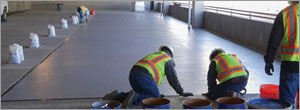| Briefly… |
|
|
|
|
|
|
|
|
|
|
| |
| Featured |
 |
| |
| Quick cure coatings with PMMA/PUMA technology |
| |
| Protection of concrete decks, foundations, and other surfaces against damage can be accomplished with a range of coating and waterproofing technologies. Gaining attention in this space are polymethyl methacrylate (PMMA) and polyurethane methacrylate (PUMA)-based solutions. |
| |
| » Read more |
| |
| What is happening behind stucco and manufactured stone? |
| |
| Stucco and manufactured stone claddings are well known for their fire-resistance abilities, durability, and aesthetics. Although stucco is a suitable choice for several reasons, improper installation will lead to one major problem—moisture infiltration. Without the right protection, uncontrolled moisture will lead to mold, wall rot, and decay, and eventually have an impact on both the aesthetics and structural integrity of the building.
|
| |
| » Read more |
|
| |
|
| |
| Inside CSI |
 |
|
| |
| |
| THE WORD INSTALLER AS A TERM OF ART |
| The word “Installer” frequently occurs in manufacturer’s guide specs. Since I was unaware of why it started with an upper-case letter, I typically replaced the upper-case “I.” Was there a generally accepted reason for using it as “term of art”? And was there a reference document that set out what it meant? |
| JOIN THE DISCUSSION » |
| |
|
| |
| |
| HANDRAILS AND ASSEMBLY AISLE WITH DIFFERENT TREAD DEPTH |
| We are replacing wall mounted handrails at an existing assembly space aisle. The stepped slab design for seating is a 36-in. run and a 14-in. rise. The aisle has a 12-in. tread and a 24-in. tread. From what I see in IBC Chapter 29, the aisle would have to be three equal treads if this were a new design. The handrail question is, “Do we have to ‘flatten’ the handrail by running it horizontal along each 24-in. depth tread?” We had hoped to set the height at the bottom and top risers and connect the two points with a straight run of handrail. With that design the handrail may not be considered “uniform” like at standard stairs. IBC 1014.2 Height (of handrails) has Exception 1 that is meant for handrail transitions at the inside railings at stair landings (where handrails rise up in height in a short distance). It allows for the height to exceed the allowable height as long as the railing is continuous. Our condition is somewhat in that spirit in that the height of the railing will rise along the 24-in. tread but the railing is still continuous. This may be hard to visualize at first but any experience with this or opinions would be greatly appreciated. |
| JOIN THE DISCUSSION » |
| |
|
|
|
| |
| Missed this from the web? |
|
|
|
|
